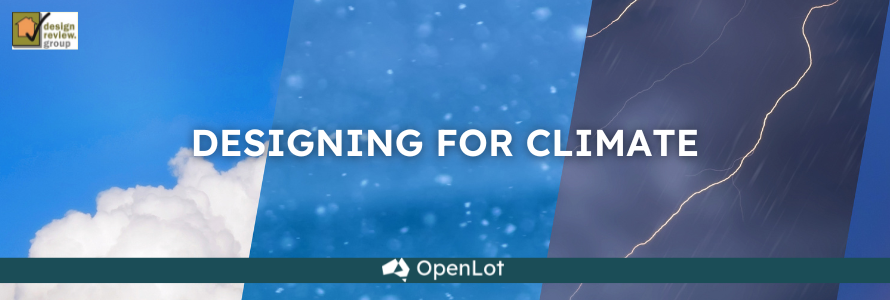
What design standards can a design code use to encourage good thermal comfort and energy efficiency? Passive design achieves good thermal comfort inside a house by working with the local climate. It’s energy efficiency at work, so good for the wallet and good for the planet. This article explains what is appropriate in each of Australia’s climate zones.
Australia’s climate zones
In most of Australia, houses require more cooling than heating. In the southern mainland, the Alps and Tasmania, more heating than cooling is needed. Identifying the climate zone the estate is in is the first step to having a design code that works with the climate.
The Building Code of Australia classifies Australia into eight climate zones with sixty-nine regional subzones. These are determined by geographic features such as latitude, wind patterns, and altitude.

Australia’s climate zones, as shown in the Building Code of Australia. (Click here for more detail)
Designing for each zone
Climate Zones 1 (hot humid summer and warm winter) and 2 (warm humid summer and mild winter): cooling in a humid environment
Orient towards breezes with openable windows. Arrange and zone spaces. Use light colours on roofs and walls.
Climate Zone 3 (hot dry summer and warm winter): cooling in a dry environment
Shade windows. Light coloured roofs and walls. Use evaporative cooling units and ceiling fans.
Climate Zones 4 (hot dry summer and cool winter) and 5 (warm temperate): summer cooling and winter heating
Summer shading of indoor and outdoor living areas. Adjustable shading for solar access. Light-coloured roofing. Catch breezes. Avoid auxiliary heating and cooling.
Climate Zone 6 (mild temperate): summer cooling and winter heating
Use the roof space as a thermal buffer. Use double glazed windows. Shade north windows and minimise east and west windows. Use light coloured roofing.
Climate Zone 7 (cool temperate): some heating
Avoid high ceilings. Use heavy insulation, insulated blinds, and heavy curtains. Orient living areas to the north and bedrooms to the west.
Climate Zone 8 (alpine): lots of heating
Have many north facing windows. Use bulk insulation. Use dark coloured roofs and walls.
For a detailed map of the climate zones, see here. To learn about design techniques for each zone, see here.
Example design suggestions
In many estates, especially price sensitive first home owner estates, the design codes include education material about sustainability. This encourages resource efficiency by giving design suggestions, rather than requiring actions using design standards. Below are some design suggestions.
Zones “Zone spaces to provide for maximum winter warmth and summer cooling through division of living spaces and reducing the areas to be heated or cooled.” (Alkimos, Shorehaven Western Australia, Zone 5)
Breezes “Dwelling orientation and design should capture breezes and maximise ventilation.” (The Reserve, Bohle Plains Queensland, Zone 1)

Colours “The roof of your home is the largest surface area exposed to the sun throughout the whole day. Choosing a light colour that will reflect the heat will reduce the amount of heat entering your home by up to 30%. (Harvest Rise, Greenbank Queensland, Zone 2)
Materials “The solar absorptance rating of the house roof must be less than 0.5…The use of low solar absorption rate materials for the roofs, walls, driveways and garage doors is recommended.” (Menangle Park, New South Wales, Zone 6)
Solar access “Dwellings must control solar access with indoor and outdoor living spaces positioned to maximise northerly aspect and include eaves to shade windows from summer sun.” (Tower Hill, Swan Hill Victoria, Zone 4)
Windows “Protection of north-facing openings from summer sun is provided with adequate internal and external shading, such as curtains, blinds, awnings, eaves, shade sails, pergolas or the use of deciduous shrubs and trees.” (Alkimos, Shorehaven, Western Australia, Zone 5)
Shading devices “Shading to homes shall be delivered to northern aspects by adopting functional roof eaves, verandahs and window shading to keep homes cool.” (Alford Grove, Toowoomba Queensland, Zone 5)
Position of spaces “Outdoor open space should be oriented to the north, however can be east/west facing if incorporating an adequate north/south dimension to allow sunlight penetration. (Quay 2, Torquay, Victoria, Zone 6)








